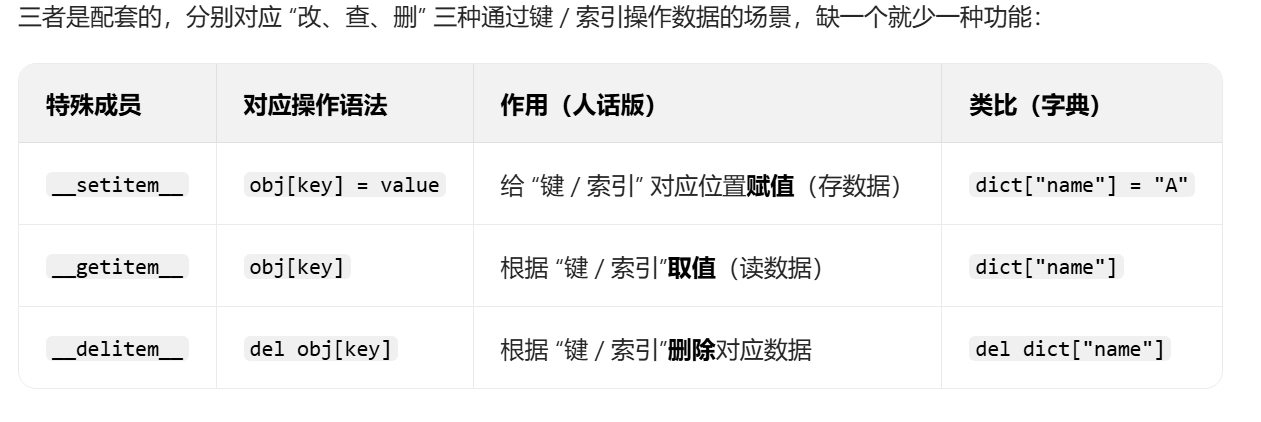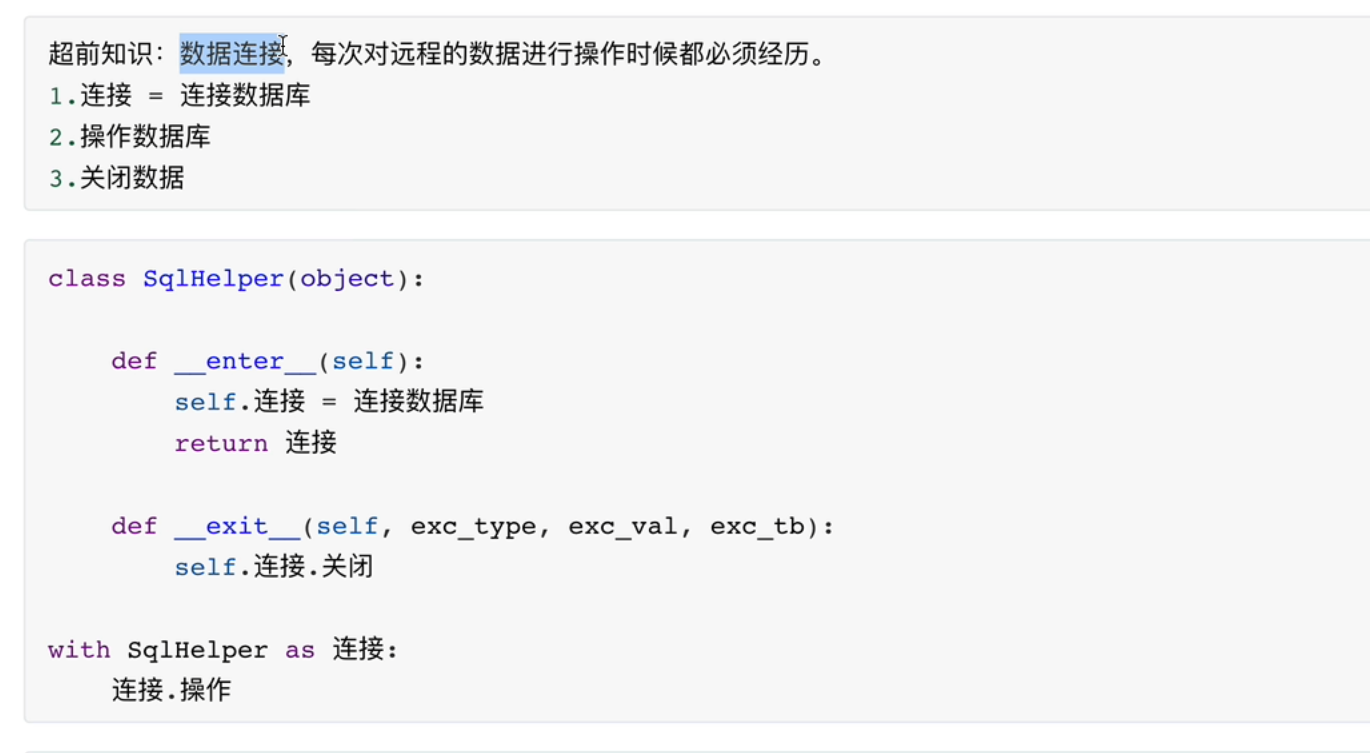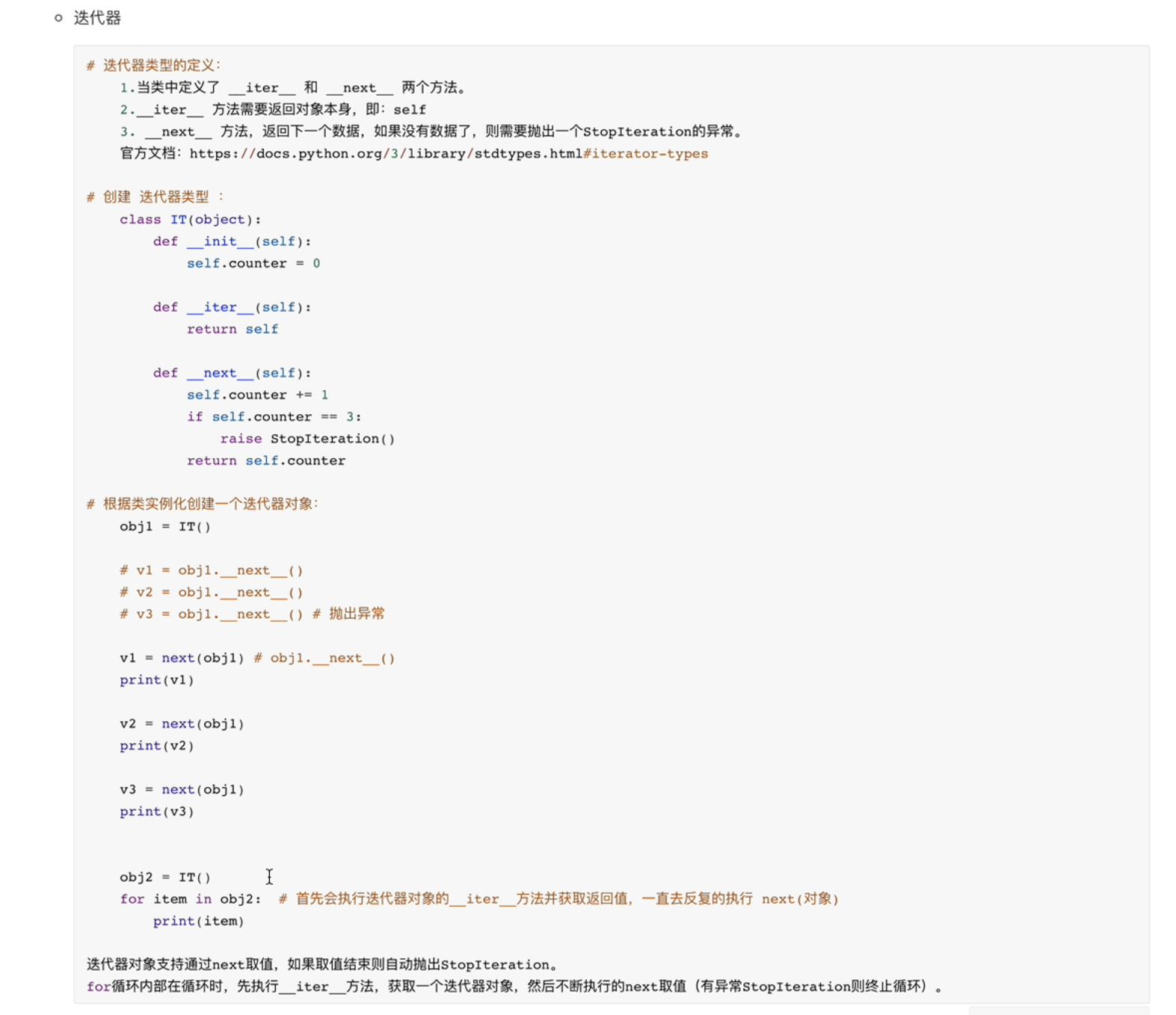面向對象進階-2
面向對象進階-2????所有類均繼承object
????1.類的嵌套:
????函數:參數可以是任意類型。
????字典:對象和類都可以做字典的key和value
????繼承的查找關系
對象和類都可以做字典的key和value
class StackConfig(object):
pass
class UserConfig(StackConfig):
pass
class AdminSite(object):
def __init__(self):
self._register = {}
def registry(self,key,arg=StackConfig):
self._register[key] = arg
def run(self):
for key,value in self._register.items():
obj = value()
print(key,obj)
site = AdminSite()
site.registry(1)
site.registry(2,StackConfig)
site.registry(3,UserConfig)
site.run()
>>>
1 <__main__.StackConfig object at 0x000002ABEEE3AB08>
2 <__main__.StackConfig object at 0x000002ABEEE3ABC8>
3 <__main__.UserConfig object at 0x000002ABEEE3AB88>
????2.特殊成員????特殊成員:就是為了能夠快速實現執行某些方法而生
__init___:??初始化方法:對對象的屬性進行初始化
__new__:??構造方法: 創建一個空對象
由于所有類均繼承object??object中含有__new__??所以創建類的對像士實際上是先__new__再__init__
__call__:??讓類的實例可以像函數一樣被調用??直接用 實例名(參數) 調用,等同于執行 實例名.__call__(參數)
class Foo:
def __init__(self):
self.__content = 0
def __call__(self):
self.__content+=1
return self.__content
obj = Foo()
print(obj()) #1
print(obj()) #2__str__:??只有在打印對象時,會自動化調用此方法,并將其返回值在頁面顯示出來
??????__str__ 方法需要返回字符串
??????簡單說:想讓 print(對象) 輸出有意義的信息,就用 __str__ 定義規則
class User(object):
def __init__(self,name,email):
self.name = name
self.email = email
def __str__(self):
return "%s %s" %(self.name,self.email,)
user_list = [User('二狗','2g@qq.com'),User('二蛋','2d@qq.com'),User('狗蛋','xx@qq.com')]
for item in user_list:
print(item)__dict__:??打印對象中封裝的所有值
class Foo:
def __init__(self,name,age):
self.name = name
self.age = age
obj = Foo('guohan',22)
print(obj.__dict__)__add__:???用于定義對象的 “加法運算” 邏輯,給自定義類 “賦能”,讓它能像數字、字符串那樣用 + 運算符????
???????當使用 + 運算符時,Python 會自動調用該方法
class info:
def __init__(self,x,y):
self.x = x
self.y = y
class Point:
def __init__(self, x, y):
self.x = x # x軸坐標
self.y = y # y軸坐標
# 重寫 __add__,定義 Point 對象的加法邏輯:x相加,y相加
def __add__(self, other):
# 先判斷 other 是否為 Point 類型,避免非法運算
if isinstance(other, Point):
# 返回新的 Point 實例(不修改原對象)
return Point(self.x + other.x, self.y + other.y)
# 若 other 類型不支持,拋出錯誤(符合 Python 內置類型的行為)
raise TypeError(f"不支持 {type(other)} 類型與 Point 類型相加")
# 使用 + 運算,自動調用 __add__
try:
p1 = Point(1, 2)
p2 = info(3, 4)
p3 = p1 + p2 # 等價于 p1.__add__(p2)
print(p3.x, p3.y)
except Exception as e:
print(f'失敗原因:{e}') #失敗原因:不支持 <class '__main__.info'> 類型與 Point 類型相加__len__:??自定義 “長度” 邏輯
????? 當對對象使用 len() 函數時,Python 會自動調用 __len__ 方法,返回對象的 “長度”
class Students:
def __init__(self):
self.list = []
def add(self,name):
self.list.append(name)
def __len__(self):
return len(self.list)
obj1 = Students()
obj1.add('guahan')
obj1.add('gh')
print(len(obj1))>>>2__eq__:??自定義 “相等” 邏輯??返回布爾類型
?????當對兩個對象使用 == 運算符時,Python 會自動調用 __eq__ 方法,判斷兩個對象是否 “相等”
class Students:
def __init__(self,name):
self.name = name
class info:
def __init__(self,name):
self.name = name
def __eq__(self,other):
if isinstance(other,info):
return self.name == other.name
raise Exception('對象類型不匹配')
try:
obj1 = info('guohan')
obj2 = Students('guohan')
print(obj1 == obj2)
except Exception as e:
print(f'比較失敗原因:{e}')
>>>比較失敗原因:對象類型不匹配
self:代表當前對象(比如 obj1)。
other:代表被比較的另一個對象(比如 obj2)。
self.name:當前對象的 name 屬性(比如 obj1.name 是 "guohan")。
other.name:被比較對象的 name 屬性(比如 obj2.name 是 "gh")。
==:判斷兩者的 name 是否相同。
return:將判斷結果(True 或 False)返回給 == 運算符__iter__:??讓對象成為迭代器
class Foo:
def __iter__(self):
yield 1
yield 2
yield 3
obj = Foo()
for i in obj:
print(i)
>>>
1
2
3
讓你自己寫的類,能用和列表、字典一樣的 “鍵 / 索引操作”(比如 obj[key]),不用額外記新方法,還能按需求自定義規則:
__setitem__:
__getitem__:
__delitem__:

#1
class Foo(object):
def __init__(self):
self.dict = {}
def __setitem__(self, key, value):
self.dict[key] = value
def __getitem__(self,key):
return self.dict[key]
def __delitem__(self,key):
del self.dict[key]
def __call__(self):
return self.dict
obj = Foo()
obj['k1'] = 123 # 內部會自動調用 __setitem__方法
obj['k2'] = 666
print(obj(),type(obj())) >>>{'k1': 123, 'k2': 666} <class 'dict'>
print(obj['k1'])
print(obj['k2'])
del obj['k2']
print(obj(),type(obj()))
#2
class Foo(object):
def __init__(self):
self.dict = {}
def __setitem__(self, key, value):
self.dict[key] = value
def __getitem__(self,key):
return self.dict[key]
def __delitem__(self,key):
del self.dict[key]
def __str__(self):
return f'{self.dict}'
obj = Foo()
obj['k1'] = 123 # 內部會自動調用 __setitem__方法
obj['k2'] = 666
print(obj,type(obj)) >>>{'k1': 123, 'k2': 666} <class '__main__.Foo'>
print(obj['k1'])
print(obj['k2'])
del obj['k2']
print(obj,type(obj))
上下文管理:??__enter__(self)??__exit__(self,exc_type,exc_val,exc_tb)??

class Foo(object):
def __enter__(self):
print('開始')
return 333
def __exit__(self,exc_type,exc_val,exc_tb):
print('結束')
#上下文管理語句
with Foo() as f: #先執行enter方法將其返回值給f再執行上下文管理語句中的內容最后去執行exit方法
print(f)
>>>
開始
333
結束
self.__class__和類.__name__:

?????3.內置函數補充
????????1.isinstance,判斷對象是不是某個類或其子類的實例??返回布爾類型
class Foo:
def __init__(self):
pass
obj = Foo()
print(isinstance(obj,Foo))????????
????????2.issubclass,判斷是否為某個類的派生類??返回布爾類型
class Foo:
def __init__(self):
pass
class Base(Foo):
pass
class Bar(Base):
pass
print(issubclass(Bar,Foo))??
????????3.super(),super() 的作用是:在當前類的 MRO 列表中,找到 “當前類的下一個類”,然后調用該類的方法
???????????????super() 的行為始終與 “實例所屬的類” 綁定,而不是與 “當前方法所在的類” 綁定
???????????????每個類都有一個 MRO 列表,定義了方法查找的順序(從當前類開始,依次遍歷所有父類,不重復、不遺漏)。
class Foo():
def func(self):
return 'guohan'
class Base(Foo):
pass
class Bar(Base):
def __str__(self):
return f'{super().func()}'
obj = Bar()
print(obj)
#super().func() 根據類的繼承關系,按照順序挨個找func方法并執行(找到第一個就不在找了)
??????4.異常處理
????????1.基本格式:
try:
pass
except Exception as e:
print(e)????????2.主動觸發異常:????raise Exception ( ' 異常原因‘ )
def run():
try:
num = input('輸入數字:')
if not num.isdecimal():
raise Exception('輸入的不是數字')#主動觸發異常,將異常信息再最后面顯示
else:
print(int(num))
except Exception as e:
print(f'異常原因:{str(e)}')
if __name__ == '__main__':
run()
>>>輸入數字:g
>>>異常原因:輸入的不是數字
????????3.finally

自定義異常\拋出異常:(寫項目時)
19-8 異常:自定義和拋出異常_嗶哩嗶哩_bilibili
初步了解:https://www.doubao.com/thread/w48582e0fb73cbf7d
??????5.迭代器,生成器,可迭代對象



應用:
可迭代對象通過循環逐一取值的可視化操作
#可視化,如何通過循環對可迭代對象進行逐一取值:循環將可迭代對象(執行可迭代對象類中的__iter__方法)————>迭代器(執行迭代器類的__next__方法)————>值
class Myiterator(object):
def __init__(self,info):
self.info = info
self.data = 0
def __next__(self):
if self.data>=len(self.info):
raise StopIteration
self.data+=1
return self.info[self.data-1]
class Myiterable(object):
def __init__(self,content):
self.content = content
def __iter__(self):
return Myiterator(self.content)
try:
content = input('輸入:')
obj = Myiterable(content)
for item in obj:
print(item)
except Exception as e:
print(e)
#嘗試將python中原本不是可迭代的對象,通過自定義可迭代對象類將其變成可迭代對象 如int
class Myiterator(object):
def __init__(self,info):
self.info = info
self.data = 0
try:
self.num = int(self.info)
except Exception as e:
print(f'輸入合法數字{e}')
def __next__(self):
if self.data>=self.num:
raise StopIteration
# val = self.info[self.data]
val = self.data #不同于python內部對迭代器類__next__方法的定義
self.data+=1
return val
class Myiterable(object):
def __init__(self,content):
self.content = content
def __iter__(self):
return Myiterator(self.content)
try:
content = input('輸入:')
obj = Myiterable(content)
for item in obj:
print(item)
except Exception as e:
print(e)
面向對象學生管理系統初步版/優化版:https://files.cnblogs.com/files/blogs/853151/%E6%A0%A1%E5%9B%AD%E7%AE%A1%E7%90%86%E7%B3%BB%E7%BB%9F%EF%BC%88%E6%95%99%E5%B8%88%EF%BC%89.zip?t=1761706276&download=true
python全部內容回顧:21 JavaScript-知識總結和回顧_嗶哩嗶哩_bilibili


 浙公網安備 33010602011771號
浙公網安備 33010602011771號